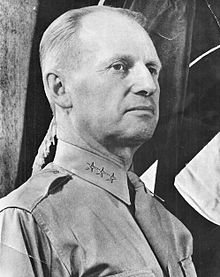Leslie McNair
| Lesley J. McNair | |
|---|---|

McNair as Army Ground Forces commander, circa 1942.
|
|
| Nickname(s) | Whitey |
| Born |
May 25, 1883 Verndale, Minnesota, United States |
| Died | July 25, 1944 (aged 61) Saint-Lô, France |
| Buried | Normandy American Cemetery and Memorial, France |
| Allegiance | United States |
| Service/branch | United States Army |
| Years of service | 1904–1944 |
| Rank |
|
| Service number | 0-1891 |
| Unit | Field Artillery Branch |
| Commands held |
Battery C, 4th Field Artillery Regiment 2nd Battalion, 16th Field Artillery Regiment 2nd Battalion, 83rd Field Artillery Regiment Civilian Conservation Corps District E, VII Corps Area 2nd Field Artillery Brigade, 2nd Infantry Division United States Army Command and General Staff School Army Ground Forces First United States Army Group (fictional) |
| Battles/wars |
Vera Cruz Expedition Pancho Villa Expedition World War I World War II |
| Awards |
Army Distinguished Service Medal (3) Purple Heart (2) Legion of Honor (France) |
| Spouse(s) | Clare Huster (m. 1905) |
| Relations | 1 son |
Lesley James McNair (May 25, 1883 – July 25, 1944) was a senior United States Army officer who served during World War I and World War II. He attained the rank of lieutenant general during his life; he was killed in action during World War II, and received a posthumous promotion to general.
A Minnesota native and 1904 graduate of the United States Military Academy, McNair was a Field Artillery officer with a background in the Ordnance Department. A veteran of the Veracruz occupation and Pancho Villa Expedition, during World War I he served as assistant chief of staff for training with the 1st Division, and then chief of artillery training on the staff at the American Expeditionary Forces headquarters. His outstanding performance resulted in his promotion to temporary brigadier general; at age 35, he was the Army's youngest general officer.
McNair's experience of more than 30 years with equipment and weapons design and testing, his administrative skills, and his success in the areas of military education and training led to his World War II assignment as commander of Army Ground Forces. In this role, McNair became the "unsung architect of the U.S. Army", and played a leading role in the organizational design, equipping, and training of Army units in the United States before they departed for overseas combat. His concentration on advanced officer education, innovative weapons systems, improved doctrine, realistic combat training, and development of combined arms tactics enabled the Army to modernize and perform successfully on the World War II battlefield, where the mobility of mechanized forces replaced the static defenses of World War I as the primary tactical consideration.
...
Wikipedia
